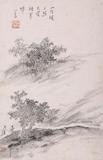明夏昶清風高節圖 軸
推薦分享
資源連結
連結到原始資料 (您即將開啟新視窗離開本站)後設資料
- 資料識別:
- 故畫000393N000000000
- 資料類型:
- 類型:繪畫
- 型式:靜態圖像
- 著作者:
- 夏昶
- 主題與關鍵字:
- 奇石 竹
- 出版者:
- 數位化執行單位:國立故宮博物院
- 日期:
- 明代宗景泰一年(1450)
- 格式:
- 本幅 137.3x43.3公分、全幅 69.5公分
- 關聯:
- 石渠寶笈初編(御書房),下冊,頁1120&*故宮書畫錄(卷五),第三冊,頁288&*故宮書畫圖錄,第六冊,頁65-66&*夏昶(西元一三八八-一四七0年),江蘇崑山人。字仲昭,號自在居士,又號玉峰。擅長畫墨竹,學自陳繼(西元一三七0-一四三四年)、王紱(西元一三六二-一四一六年)。 傍石而生的脩竹,隨風搖曳,頗有動感。竹幹畫的挺拔,竹葉則勁健,墨色有著明顯的前後濃淡之別。另畫石的筆墨極重,顯出石的厚實,和竹的飄逸兩相對映,意趣無窮。&*Lofty Bamboo in a Pure Breeze Hsia Ch’ang (1388-1470) Ming Dynasty Hsia Ch’ang, a native of K’un-shan in Kiangsu Province, excelled at painting bamboo in monochrome ink, which he learned from Ch’en Chi (1370-1434) and Wang Fu (1362-1416). Tall bamboos are shown growing behind a rock as they sway in the breeze, imbuing this work with a sense of grace and movement. The bamboo stalks are painted to show their upright straightness as well as flexibility. The leaves appear robust as the ink tones are clearly distinguished between light and dark. The brushwork in painting the stone is somewhat heavier, giving it a sense of solidity and volume. The contrast between it and the light swaying bamboo gives this work a unique quality revealing Hsia’s specialty in painting bamboo. &* 夏昶(西元一三八八-一四七○年),江蘇崑山人。字仲昭,號自在居士,又號玉峰。明成祖永樂十三年(一四一五)考中進士,官至太常卿。擅長於墨竹,畫法學自陳繼、王紱。 本幅畫奇石修竹,竹幹挺拔,竹葉勁健,用筆用墨瀟灑出塵,具清妍秀雅之趣。畫石則筆墨極重。二者墨色濃淡相映,清濁相形,意趣無窮。 &*Bamboo in the Wind Hsia Ch’ang (1388-1470) Ming Dynasty Hsia Ch’ang (style name Chung-chao; sobriquets Tzu-tsai chü-shih and Yü-feng) was a native of K’un-shan, Kiangsu. In 1415 he passed the examination for the chin-shih civil service degree and ultimately served as Chief Minister of the Court of Imperial Sacrifices. He excelled at depicting bamboo in monochrome ink, the methods for which he learned from Ch’en Chi and Wang Fu (1342-1416). This is a painting of unusual rocks and tall bamboo. The bamboos stand upright with vigorous and robust growths of leaves. The use of brush and ink is pure, ethereal, and unsullied, thus imparting a taste of beauty and elegance. The painting of the rocks was strongly emphasized with brush and ink. The contrast between the light and heavy ink tones of the bamboo and rock can be compared to that of refined versus sullied, thus imbuing a rich meaning to the painting. &* 夏昶,江蘇崑山人。生於明洪武二十一年,成化六年卒(一三八八-一四七○)。字仲昭,號自在居士,又號玉峯。以朱姓、登永樂乙未進士,後復姓。入詞垣,改中書舍人,正統(一四三六-一四四九)間仕至太常卿。竹石師王紱,早歲類其筆意,其後稍變,時推第一。畫竹煙姿雨色,偃直疏濃,各循矩度。詩詞清麗,並精楷書。 本幅地上奇石矗立,墨法乾濕並用。石後修竹三竿,亭亭玉立,畫葉則「个」「介」相叠,濃淡分出前後。似有微風穿過,竹葉將欲翩翩舞動。 &*Bamboo in the Wind Hsia Ch’ang (1388-1470) Ming Dynasty Both dry and wet ink have been used to depict the angular rocks that jut up from the ground; from behind the rocks protrude three slender, graceful stalks of bamboo. Alternate clusters of three and four leaves each are executed in varying tones of heavy and light ink. It seems as if a slight wind is blowing through the leaves, making them dance lightly in the air. Hsia Ch’ang (whose style name was Chung-chao and sobriquets were Carefree and Jade Peak) was from K’un-shan in Kiangsu. In his paintings of bamboo and rocks he followed Wang Fu, initially emulating Wang’s style of brushwork but eventually altering it slightly, thereafter becoming known as a first-rate painter.
- 管理權:
- 國立故宮博物院
授權聯絡窗口
- 國立故宮博物院圖像授權、出版授權、影音資料授權-申請流程說明
http://www.npm.gov.tw/zh-TW/Article.aspx?sNo=03003061






